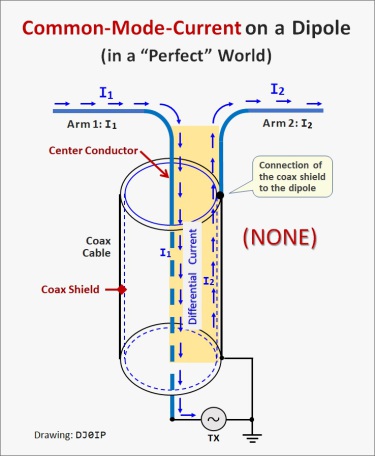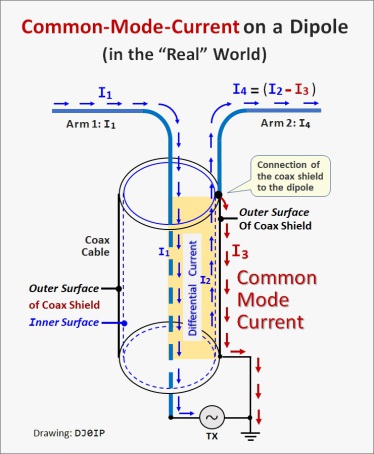Detailed Explanation of CMC
(Common-Mode-Current)
How or why does RF flow on the Outside of the Coax?
It should be obvious that we want RF Current to flow inside of our coax, from the transmitter to the antenna, and then be radiated by (and only by) the antenna.
In reality, this is almost never the case.
- In reality there is always a little bit of RF flowing along the outside of the coax shield.
- The good news is, a little bit of RF flowing on the outside of the shield usually does not harm anything and is unnoticiable.
- Unfortunately there is often a lot of RF flowing on the outside of the shield and this can have many severe consequences.
IMPORTANT: At HF frequencies, Skin Effect causes RF to flow on the surface of a wire, rather than inside of it. The coaxial shield has two surfaces, one inside oand one outside. Together with the center conducter, it has, with respect to RF, 3 wires! Therefore, RF Current flowing on the inside surface of the shield is different from RF Current flowing on the outside of the shield.
RF Current flowing along the outside shield of the coax is known as Common-Mode-Current (CMC). It does all kinds of nasty things, as explained on the previous page on Simple Basic Theory.
Several things may cause CMC . . . (this topic will be continued later)
The two drawings below explain exactly why CMC flows on the outside surface of the shield when we do not use a good balun to connect the unbalanced coax to the balanced antenna.
Perfect (Dream) World
The drawing on the right shows what we would like to have.
The RF flowing inside of the coax from the transmitter to the antenna is called Differential Current. An inherent feature is that it is undisturbed from whatever is going on around it on the outside.
When the RF reaches the dipole antenna, ALL of the RF flows into the antenna and is radiated.
In a perfect world, every year is a sunspot maximum and there is no QRM.
Unfortunately we do not live in a perfect world and antenna systems do not always work like we want them to.
Imperfect (Real) World
The drawing on the right shows what happens when we connect the coax transmission line directly to the dipole, without the use of a balun.
RF from the transmitter flows inside of the coax until reaching the arms of the antenna. At the point where the arm of the antenna connecto to the shield, the RF from the transmitter sees two paths to groung:
- The capacitive coupling between the antenna arm and the earth below it.
- The D.C. path along the outside surface of the shield.
At his point, the RF splits at and:
- part of it flows through the antenna's arm and is radiated as we wish it to;
- and part of it flows along the outer surface of the shield to ground. In doing so, it does what RF Current flowing along a wire always does, it radiates.
to be continued . . .



























